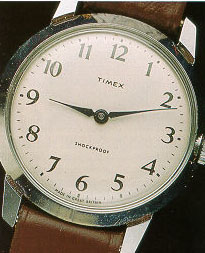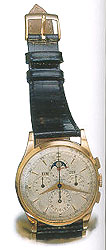The Timex V-Conic Mickey Mantle taped one to his bat and hit 50 balls into the seats. A racehorse galloped around the Belmont racetrack with one strapped to his leg. A giant lobster spent hours underwater with one tied to its claw. What were they all trying to prove? Just this - that a Timex takes a licking a keeps on ticking. Mickey Mantle taped one to his bat and hit 50 balls into the seats. A racehorse galloped around the Belmont racetrack with one strapped to his leg. A giant lobster spent hours underwater with one tied to its claw. What were they all trying to prove? Just this - that a Timex takes a licking a keeps on ticking.
U.S. Time launched its world-famous armored tank of a watch in 1950. Except for a few nurses' watches marketed in 1945, it was the first watch to bear the Timex name. (The company itself was renamed "Timex" in 1969.) What made it so durable was its "V-Conic" escapement, which had a cone-shaped balance staff (hence the name) that rotated in bearings made of a very hard alloy called "Armalloy." The balance staff is a watch's most delicate component, the one most likely to be displaced by a jolt, so making it sturdier greatly enhanced the watch's shock-resistance. In addition, the movement had fewer parts than other watch movements, which made it even more durable. The watch wasn't just tough, it was cheap, with prices ranging from $6.75 to $7.95. And it was reasonably accurate, off by a minute or two a day - not bad given the watch's bargain-basement price. Consumers snapped the watches up. By 1951, the company had produced almost 2 million of them and enjoyed an 18 percent share of the low-priced segment of the U.S. watch market. But that was nothing. When U.S. Time began to promote the watch aggressively in 1952, sales took off like one of Mantle's homers. The company launched a major print advertising campaign describing the various "torture tests" the watch could endure - home runs, horse races, lobster tanks, etc. In 1956, U.S. Time began airing its now legendary torture-test TV commercials featuring John Cameron Swayze. The hard-headed V-Conic catapulted the Timex brand starward. By 1963, nearly half the watches sold in the U.S. were from Timex. By 1967, it was the world's best-selling watch brand.
None did they enjoy more than the Universal Geneve Tri-Compax, launched in 1944. It was the most popular chronograph of the '40's and '50's and one of the most famous ever made. It combines an eye popping array of functions and auxiliary dials: counters for the hours and minutes, a constantly running seconds subdial, indicators for day, date, month and phases of the moon, a tachymeter scale and chronograph-seconds scale graduated to 1/5 of a second. All these dials and scales sit gracefully onto an elegant-looking dial. It was a kind of culmination of chrono technology. Its manufacturer had long roots in the chronograph business. Early in the '30s Universal Geneve had introduced the first chrono with two buttons instead of one, the Compur. This was a big step forward, because it allowed the user to srop and start the seconds hand without having automatically return to zero. In 1936 Universal Geneve unveiled another improvement, the world's first hour counter, which meant you could time longer events than ever before. Up until then, chrono counters could keep track of periods no longer than 45 minutes. It called this watch the Compax, the first in a series that led to the Tri-Compax eight years later. Give the watch's impressive features, it's no wonder that Universal Geneve nicknamed it "Glorious." Judging by the watch's following then and now, few would argue with that choice. |
 Every watch fan remembers the chrono craze, the passion for chronograph wristwatches that began in Europe in the mid-80's and hit our shores a couple of years later. What few remember is the craze's precursor, in the 1930's and '40's, when chronograph technology and production techniques sprinted forward and people discovered the joys of playing with these push-button timers, then widely available for the first time.
Every watch fan remembers the chrono craze, the passion for chronograph wristwatches that began in Europe in the mid-80's and hit our shores a couple of years later. What few remember is the craze's precursor, in the 1930's and '40's, when chronograph technology and production techniques sprinted forward and people discovered the joys of playing with these push-button timers, then widely available for the first time.
